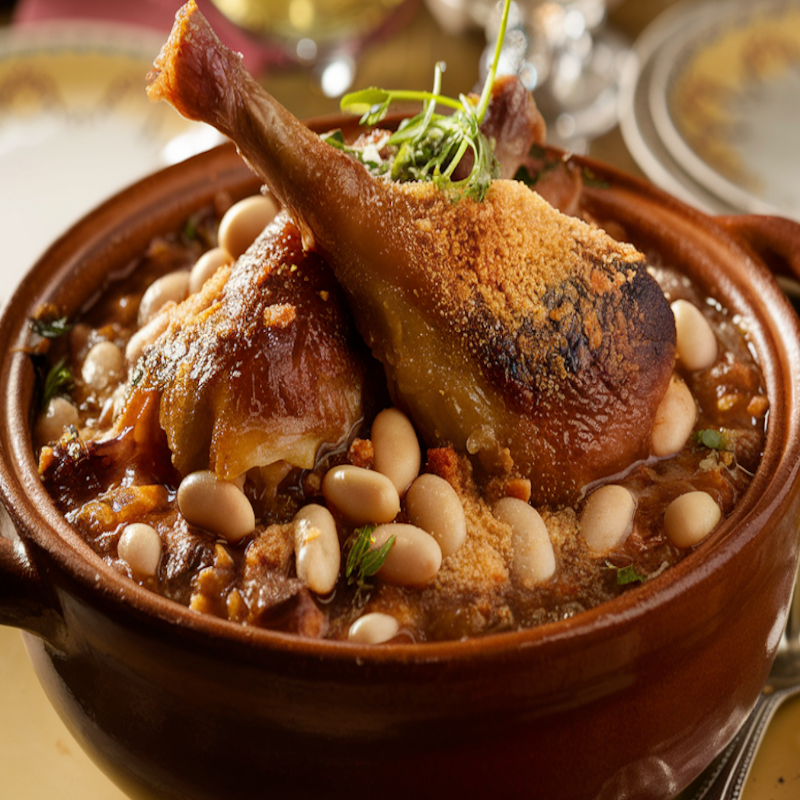Traditional Toulouse Cassoulet
An Authentic Dish from the South-West Cuisine
The Traditional Toulouse Cassoulet is an iconic dish from the region, rich in flavors and traditions. To ensure the best quality of this dish, we recommend ordering it at least one week in advance to allow for the meticulous preparation process required for a perfect result.
Wine Pairing:
To accompany a cassoulet, a dish that is both hearty and flavorful, it is essential to choose a wine that will complement its aromas without overpowering them. Here are some suggestions you can find on our website:
-
Red Wine from the South-West Region
- Cahors (Malbec): A powerful red wine with notes of dark fruits and strong tannins, making it ideal for matching the richness of the cassoulet.
- Madiran: With its ripe fruit notes and tannic structure, this robust wine is a perfect match for a hearty cassoulet.
-
Red Wine from Bordeaux
- Saint-Emilion or Pomerol: These wines, more refined but still with good structure, pair well with the texture of the dish and the intensity of the meat.
-
Dry White Wine
- Jurançon Sec: If you prefer a white wine, a dry Jurançon, with its minerality and acidity, offers a refreshing contrast to the rich and fatty nature of the cassoulet.
To explore more wine pairing options and to order your cassoulet, visit our website!
 Garanties sécurité
Garanties sécurité
(à modifier dans le module "Réassurance")
 Politique de livraison
Politique de livraison
(à modifier dans le module "Réassurance")
 Politique retours
Politique retours
(à modifier dans le module "Réassurance")
Traditional Toulouse Cassoulet “Moustache Style”
Ingredients:
- Tarbais white beans (Red Label): 500 g
- Duck confit: 4 legs
- Pork ribs (farm-raised): 300 g
- Pork trotter: 1
- Pork rind: 250 g (half for assembling)
- Toulouse sausage: 500 g
- Pork meat (shank, shoulder, or belly): 4 pieces of 50 g each
- Lacaune ham trimmings: 150 g, diced
- Carrot: 1, sliced into rounds
- Onions: 2, finely chopped
- Celery: 1 stalk
- Goose fat: 3 teaspoons
- Bay leaf: 1
- Thyme sprig: 1
- Chicken stock: about 1 liter
- Poultry carcass or pork bones: for a flavorful broth
- Garlic cloves: 4, crushed
- Salt and pepper: to taste
Preparation:
The Day Before:
- Soak the white beans in cold water overnight.
The Next Day:
1. Cooking the Beans:
- Drain the soaked beans and place them in a large pot with cold water.
- Bring to a boil and cook for 5 minutes, then drain again and set aside.
2. Preparing the Broth:
- In a large pot, heat the goose fat and sauté the onions and diced ham until translucent.
- Add the poultry carcass, pork bones, pork trotter, carrot, celery, bay leaf, thyme, and pork rind (cut into wide strips).
- Pour in the chicken stock, season with salt and pepper, and simmer gently for 1 hour.
- Strain the broth and set the pork rind aside.
3. Cooking the Beans in the Broth:
- Cook the beans in the strained broth until tender but still firm, about 1 hour.
4. Preparing the Meats:
- In a large frying pan, brown the pork ribs, pork trotter, and pork pieces (shank, shoulder, or belly) in goose fat until golden. Set aside.
- In the same pan, brown the Toulouse sausages and set aside.
- Gently heat the duck confit legs to melt off excess fat, then set aside.
5. Preparing the Beans:
- Drain the cooked beans, keeping the broth.
- Mix the beans with the crushed garlic and diced Lacaune ham trimmings.
Assembling the Cassoulet:
1. Choosing the Dish:
- Use a "cassole" or a deep oven-safe clay dish.
2. Layering:
- Line the bottom of the dish with pork rind.
- Add one-third of the beans.
- Arrange the meats (duck legs, pork pieces) on top.
- Cover with the remaining beans and partially bury the sausages, leaving them slightly exposed.
- Pour the hot broth over the beans, just enough to cover them.
- Drizzle a tablespoon of goose fat over the top and season with pepper.
Cooking:
1. Baking the Cassoulet:
- Preheat the oven to 150-160°C (300-325°F).
- Bake the cassoulet for 2 to 3 hours.
- During cooking, a golden crust will form on top. Push it down into the cassoulet several times to enhance the flavors. Add more broth if the top starts to dry out.
2. Reheating (if made in advance):
- If prepared the day before, reheat the cassoulet in the oven at 150°C (300°F) for about 1.5 hours before serving. Add extra broth or water if necessary.
Serving:
- Serve the cassoulet directly in its clay dish, bubbling and golden, without stirring to preserve the layers and textures.
- Pair with a robust red wine from the Southwest of France for a complete experience.
Tip:
This hearty, comforting dish is perfect for family meals or gatherings with friends. It embodies the rich culinary traditions of the French Southwest!


